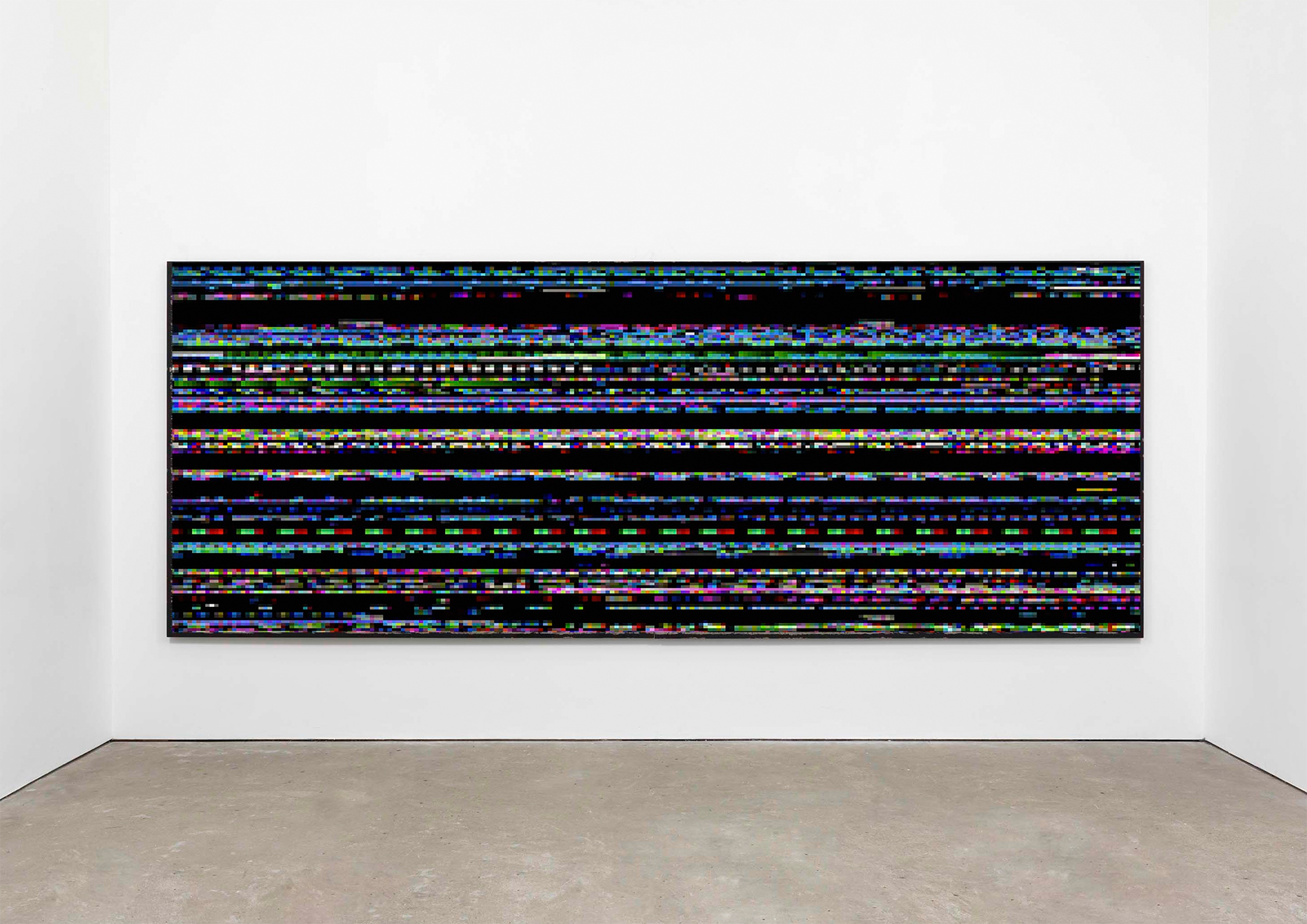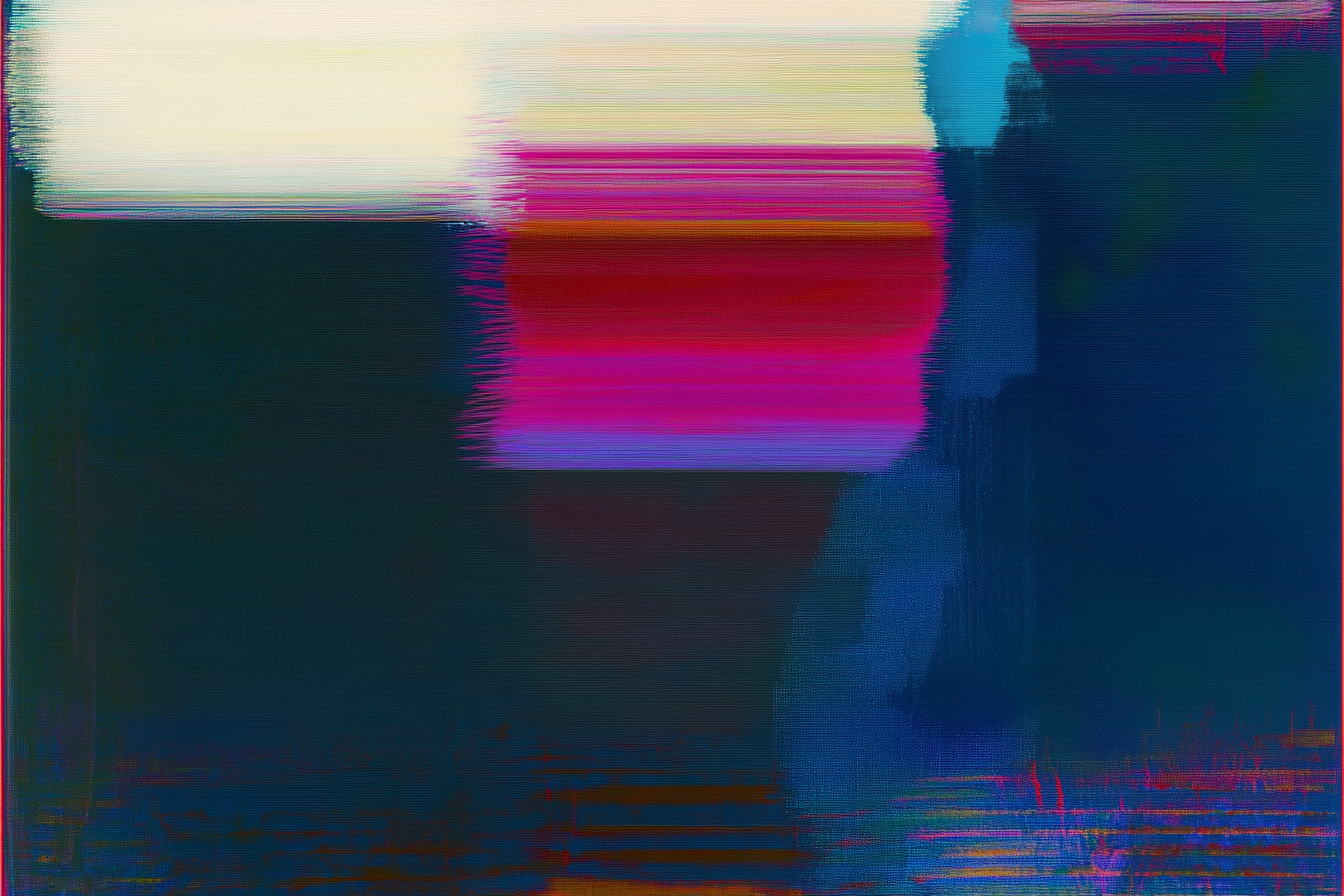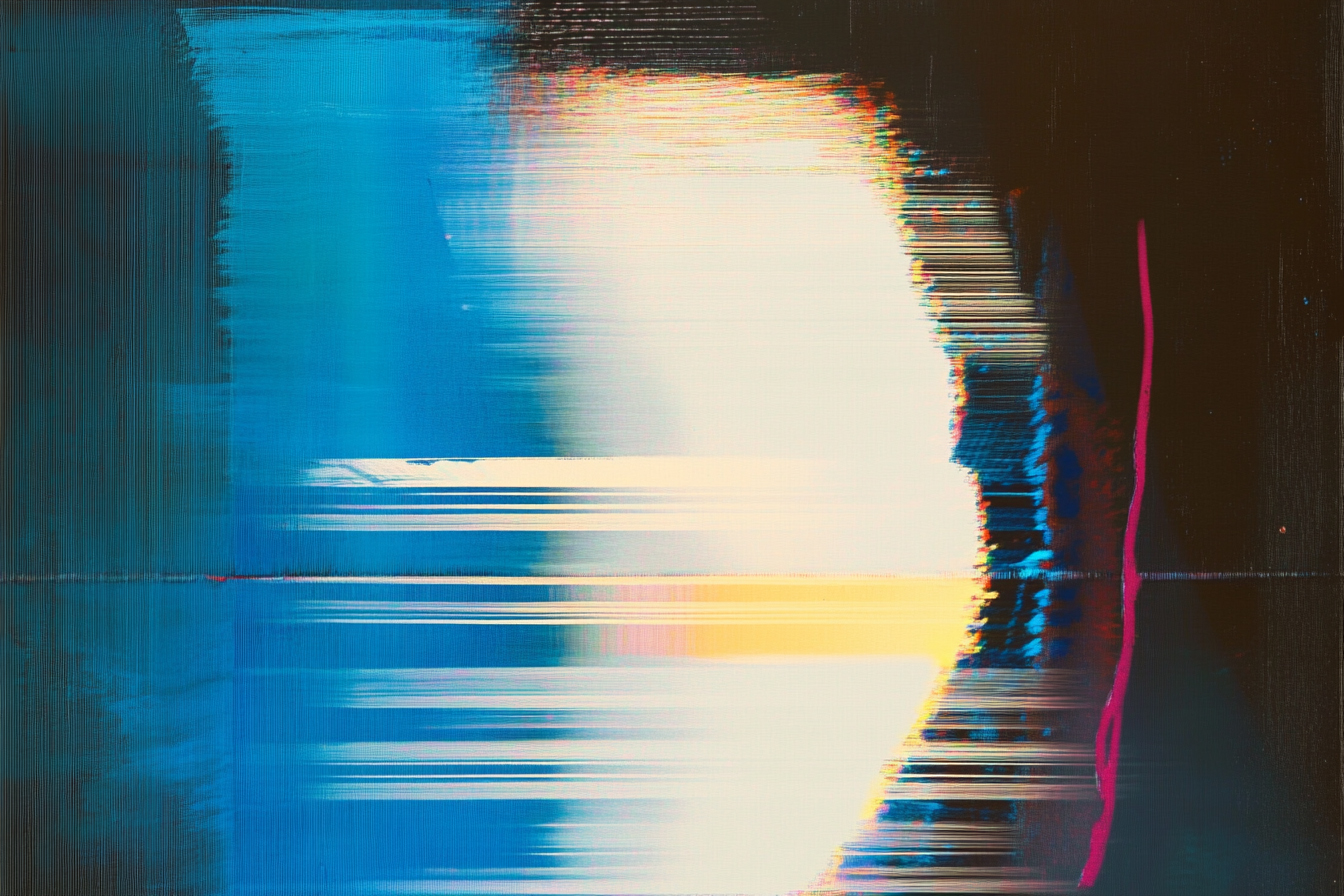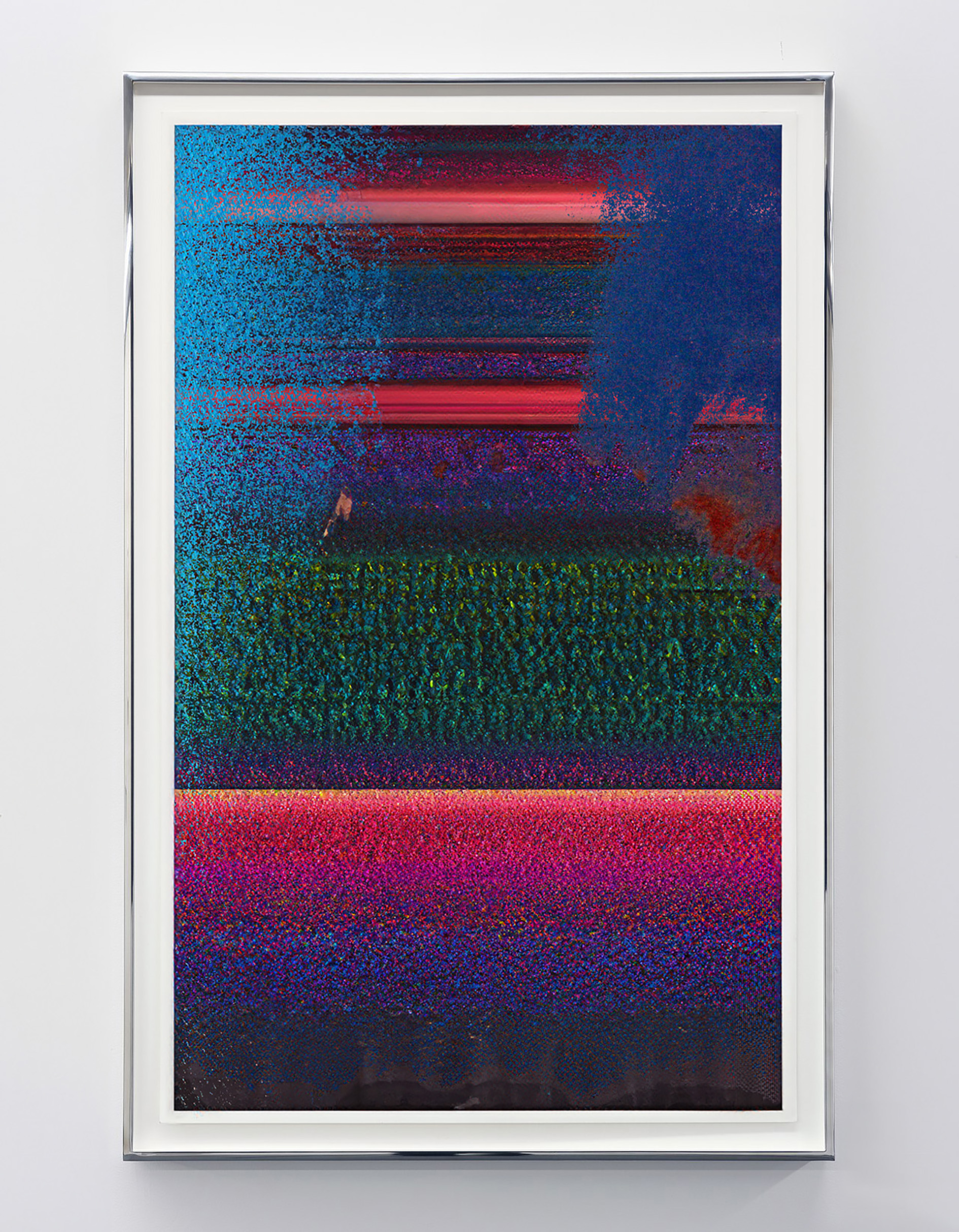In a Landscape
A series of photographic works by recovering data from the hard drives that had been thrown out of a 6th-floor studio window and contained all of my old photographic works.














Winds do not form on their own, they attach to objects to take shape. Landscape is simply inhuman. And all the rest is simply projection.
The hard drive plummeted from the sixth-floor window, its photographic works reduced to garbled code, as if consciousness itself had dissolved, scattering into countless fragments of data. In the ancient Indian Avatamsaka Sutra, the universe is envisioned as Indra’s Net, a vast web suspended across the cosmos, each jewel at its nodes reflecting all others in an infinite interplay of light and form. So too, my works, dispersed in the wreckage of the hard drive, were reborn through data recovery, as if fragments of consciousness flowed through reality’s myriad data points, awaiting recombination.
Sitting in stillness, observing the world around me, I realize that everything I see is a projection of my mind. The landscape, the people, the very fabric of reality—all of it is shaped by my perception. In The Platform Sutra, it is written: “Sometimes the wind blows, and the banner moves. One monk says the wind is moving, another says the banner is moving. The debate goes on. Then Huineng says: ‘It’s not the banner that moves, nor is the wind, it’s your heart.’” The heart’s motion is like the flow of data: what appears as an image is, in truth, the recombination of countless minute fragments. The Avatamsaka Sutra describes Indra’s Net, a cosmic web where each jewel mirrors the entirety of existence, interpenetrating, boundless. My photographs, scattered in the hard drive’s ruins, were reborn through restoration, as if shards of consciousness were reflected and reassembled in the radiant lattice of Indra’s Net. The words of Wang Yangming are: When I do not look at the flower, the flower is in the same tranquility as my heart. When I look at the flower, then the flower has a hundred colors and has entered my heart. In Buddhist terms, all laws and ideals are created, all phenomena are nothing but mind. The heart never speaks, but you must listen to know.
From Plato and Aristotle to Kant and Hegel, idealist philosophers assert that the external world is a construct of the mind, shaped by subjective perception and interpretation. This challenges the dichotomy between subjectivity and objectivity, suggesting that reality itself is a product of our perception and comprehension.
Everything is interconnected. In reality, it is not others who observe us but our own selves. The brain serves as the projector, conjuring our three-dimensional world from the two-dimensional images captured by our retinas. The intricate dance between sight and cognition may give rise to optical illusions. The disjunction between reality and our perception thereof reveals that what we perceive is but a filtered interpretation of reality, a projection of our consciousness. Our preoccupation with the opinions of others stems from an incomplete acceptance of ourselves. Another interpretation of “not caring about others’ opinions” is that their perceptions of us are reflections of their own worldview. Thus, the “you” in the eyes of others is not truly “you”; rather, the “others” in your own eyes are the genuine reflections of your being.
I am not what you think I am,
You are what you think I am.
My perspective is but one among myriad ways of perceiving the world. The Buddhist principles of emptiness, impermanence, and dependent origination resonate with the notion of reality as a projection of the mind. What I perceive and experience is shaped not only by the landscape around me but also by my own consciousness and the lens through which I view the world. In this moment, I feel both connected to everything and detached from it all—a paradoxical experience underscoring the fundamental interdependence of all phenomena.
In Chinese philosophy, the Taoist concept of the origin of all things is epitomized by Laozi’s words in Chapter 42 of the Dao De Jing: “The Dao gives birth to One, the One gives birth to Two, the Two gives birth to Three, and the Three give birth to all things. All things carry the One.” This tenet encapsulates the Taoist worldview, emphasizing the unity and diversity of the universe. I find that this philosophical concept harmonizes with the underlying themes of my work. The “One, Two, Three” herein represent not concrete entities or numerical values but rather signify a progression from simplicity to complexity, from singularity to plurality, mirroring Laozi’s assertion that “Heaven and earth were born of the non-being.” Thus, the “Dao gives birth to One” denotes the transition from non-being to being—the genesis and evolution of the cosmos. Initially, the universe existed in a state of unity, symbolizing boundlessness or eternity. Subsequently, dualistic opposites emerged—yin and yang, motion and stillness, void and substance—giving rise to the myriad dichotomies and relativities within the cosmos. Through the interplay and transformation of these dualities, all phenomena manifested—comprising the entirety of existence. The notion that “All things carry the One” underscores the intrinsic unity of the universe. Despite outward appearances of diversity and multiplicity, all phenomena emanate from a singular source—the Dao, the foundational principle of Daoism. All manifestations are but expressions of this singular essence and ultimately converge back to this unified origin.
These works— photographs captured, digitized, and stored on a hard drive—a culmination of years of creative endeavor, a digital archive of memories immortalized in imagery. Subsequently, during a catastrophic data loss, chaos ensued, scattering, erasing, and resetting the contents to zero. Consciousness, like data, disperses yet can be recombined, its fragments akin to jewels in Indra’s Net, each reflecting the whole, awaiting reassembly. Yet through meticulous data recovery and reconstruction, the amalgamation of fragmented pieces was restored, culminating in the manifestation of the present iteration of the work. Each reborn image emerges from the chaos of countless minute data points, as if consciousness, reflected in the jewels of Indra’s Net, scatters into infinitesimal particles yet encompasses the cosmos entire.
The universe itself is a vast hard drive, an boundless web of Indra’s Net, storing the backups of all consciousness—our memories, perceptions, and existence, lingering in the infinite lattice of cause and effect, awaiting recombination. Landscape is silent, yet the heart resonates within the cosmic web.
All forms dissolve, all memories scatter, yet consciousness, like light in the jeweled net, always finds its way back to wholeness.
2014
The hard drive plummeted from the sixth-floor window, its photographic works reduced to garbled code, as if consciousness itself had dissolved, scattering into countless fragments of data. In the ancient Indian Avatamsaka Sutra, the universe is envisioned as Indra’s Net, a vast web suspended across the cosmos, each jewel at its nodes reflecting all others in an infinite interplay of light and form. So too, my works, dispersed in the wreckage of the hard drive, were reborn through data recovery, as if fragments of consciousness flowed through reality’s myriad data points, awaiting recombination.
Sitting in stillness, observing the world around me, I realize that everything I see is a projection of my mind. The landscape, the people, the very fabric of reality—all of it is shaped by my perception. In The Platform Sutra, it is written: “Sometimes the wind blows, and the banner moves. One monk says the wind is moving, another says the banner is moving. The debate goes on. Then Huineng says: ‘It’s not the banner that moves, nor is the wind, it’s your heart.’” The heart’s motion is like the flow of data: what appears as an image is, in truth, the recombination of countless minute fragments. The Avatamsaka Sutra describes Indra’s Net, a cosmic web where each jewel mirrors the entirety of existence, interpenetrating, boundless. My photographs, scattered in the hard drive’s ruins, were reborn through restoration, as if shards of consciousness were reflected and reassembled in the radiant lattice of Indra’s Net. The words of Wang Yangming are: When I do not look at the flower, the flower is in the same tranquility as my heart. When I look at the flower, then the flower has a hundred colors and has entered my heart. In Buddhist terms, all laws and ideals are created, all phenomena are nothing but mind. The heart never speaks, but you must listen to know.
From Plato and Aristotle to Kant and Hegel, idealist philosophers assert that the external world is a construct of the mind, shaped by subjective perception and interpretation. This challenges the dichotomy between subjectivity and objectivity, suggesting that reality itself is a product of our perception and comprehension.
Everything is interconnected. In reality, it is not others who observe us but our own selves. The brain serves as the projector, conjuring our three-dimensional world from the two-dimensional images captured by our retinas. The intricate dance between sight and cognition may give rise to optical illusions. The disjunction between reality and our perception thereof reveals that what we perceive is but a filtered interpretation of reality, a projection of our consciousness. Our preoccupation with the opinions of others stems from an incomplete acceptance of ourselves. Another interpretation of “not caring about others’ opinions” is that their perceptions of us are reflections of their own worldview. Thus, the “you” in the eyes of others is not truly “you”; rather, the “others” in your own eyes are the genuine reflections of your being.
I am not what you think I am,
You are what you think I am.
My perspective is but one among myriad ways of perceiving the world. The Buddhist principles of emptiness, impermanence, and dependent origination resonate with the notion of reality as a projection of the mind. What I perceive and experience is shaped not only by the landscape around me but also by my own consciousness and the lens through which I view the world. In this moment, I feel both connected to everything and detached from it all—a paradoxical experience underscoring the fundamental interdependence of all phenomena.
In Chinese philosophy, the Taoist concept of the origin of all things is epitomized by Laozi’s words in Chapter 42 of the Dao De Jing: “The Dao gives birth to One, the One gives birth to Two, the Two gives birth to Three, and the Three give birth to all things. All things carry the One.” This tenet encapsulates the Taoist worldview, emphasizing the unity and diversity of the universe. I find that this philosophical concept harmonizes with the underlying themes of my work. The “One, Two, Three” herein represent not concrete entities or numerical values but rather signify a progression from simplicity to complexity, from singularity to plurality, mirroring Laozi’s assertion that “Heaven and earth were born of the non-being.” Thus, the “Dao gives birth to One” denotes the transition from non-being to being—the genesis and evolution of the cosmos. Initially, the universe existed in a state of unity, symbolizing boundlessness or eternity. Subsequently, dualistic opposites emerged—yin and yang, motion and stillness, void and substance—giving rise to the myriad dichotomies and relativities within the cosmos. Through the interplay and transformation of these dualities, all phenomena manifested—comprising the entirety of existence. The notion that “All things carry the One” underscores the intrinsic unity of the universe. Despite outward appearances of diversity and multiplicity, all phenomena emanate from a singular source—the Dao, the foundational principle of Daoism. All manifestations are but expressions of this singular essence and ultimately converge back to this unified origin.
These works— photographs captured, digitized, and stored on a hard drive—a culmination of years of creative endeavor, a digital archive of memories immortalized in imagery. Subsequently, during a catastrophic data loss, chaos ensued, scattering, erasing, and resetting the contents to zero. Consciousness, like data, disperses yet can be recombined, its fragments akin to jewels in Indra’s Net, each reflecting the whole, awaiting reassembly. Yet through meticulous data recovery and reconstruction, the amalgamation of fragmented pieces was restored, culminating in the manifestation of the present iteration of the work. Each reborn image emerges from the chaos of countless minute data points, as if consciousness, reflected in the jewels of Indra’s Net, scatters into infinitesimal particles yet encompasses the cosmos entire.
The universe itself is a vast hard drive, an boundless web of Indra’s Net, storing the backups of all consciousness—our memories, perceptions, and existence, lingering in the infinite lattice of cause and effect, awaiting recombination. Landscape is silent, yet the heart resonates within the cosmic web.
All forms dissolve, all memories scatter, yet consciousness, like light in the jeweled net, always finds its way back to wholeness.
2014